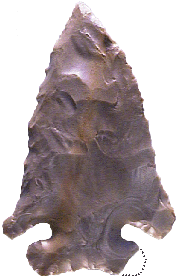

Point Type: THEBES
a.k.a. Cache River
Diagonal Notched, Archaic Bevel
Also See: Big Sandy, Bolen,
Cobbs
Triangular, Cypress Creek
I, Dover Hill,
Expanded Notched, Hardin, Houston, Kirk Corner
Notched
, Lost Lake, St. Charles aka: Dovetail
Location: Midwestern United States
Associated Dates:
10000 - 8000 B.P. - Early Archaic
Morphology: Side
Notched or Corner
Notched
General Description: The Thebes is a medium to large sized, thick, side or corner notched point that is usually beveled on one side (usually the left side) of each face. The type is generally large with deep corner notches or side notches which can have one of four shape treatments. The basal edge is almost always heavily ground. The blade edges can sometimes be serrated. The blade shape varies considerably within the type due to the resharpening processes but is generally triangular in form. The pristine form of the Thebes type has an excurvate blade edge with no beveling present. As the blade was used and resharpened and reworked, the blade outline changed and the blade edges tend to become more straight and then incurvate. The cross section tends to be flat and then as bevels are formed the cross section becomes rhomboid.
The base on the Thebes point is is varied in outline and can have a straight, slightly concave or convex basal edge.
There are four subtypes or varieties of the Thebes type. These are called the Diagonal Notched (so named for the diagonal notch that angles upward from the base towards the distal end, most common in Illinois, Indiana and Missouri), the Dogleg Notched (so named for the distinctive upward-curved notch shape, most common in Ohio), the E-Notched (so named for the E shaped termination of the notch, most common in Indiana, Ohio and Pennsylvania) and the Square Notched (so named for the wide squared appearance of the notch termination). These four subtypes were the result of the the University of Cincinnati Point Type Conference which was held in 1983.
The Thebes probably functioned as a large knife form and the many examples found tend to exhibit extensive rework and resharpening to a size which is smaller than the characteristic thick and broad base. In fact, on some discarded and exhausted specimens, the hafting area (remember, the hafting area was protected under the sinew and lashings from the effects of rework and thus remained large) of the base is so large and out of proportion to the stub of a remaining blade, that I often find myself grimacing at the overall shape of the ungainly artifact.
The weakest point of the form is the neck of the stem and large blades without stems are often recovered in the fields.
The Thebes type is common in the Indiana and Ohio and is also found throughout Illinois, eastern Missouri, northern Kentucky, northern West Virginia, eastern Pennsylvania, southwest Virginia, southern Michigan, southern Wisconsin and Iowa. Baker names a type called the Houston, found in Alabama which for all intents appears to be related to the Thebes.
The size range of the Thebes point is between 40 mm and 117 mm in length, with the average being 57 mm. The width is between 28 mm and 63 mm wide across the barbs. The thickness is between 7 mm to 12 mm with a stem 13 mm to 26 mm long and 23 mm to 46 mm wide across the stem. The notch depth of the Thebes point ranges from 5mm to 12 mm in length and the notch is 4 mm to 10 mm wide. Three out of every four specimens of 75 measured were beveled and 97% had basal grinding.
The Thebes point was named by Howard D. Winters in 1963 for examples which were recovered from his survey of the Wabash River Valley in Illinois. Winters originally called this type the Cache River Diagonal Notched point that was intended to be included in a Thebes cluster or assemblage. Winters suggested that the Cache River Diagonal Notched name be discarded and this was accepted at the University of Cincinnati Point Type Conference of 1983.
About the Point Above: The fine Thebes diagonal notched type blade pictured at the top of this page, was found in a cornfield near the Ohio River, outside of Tell City, Perry County, Indiana. The point is made from a dark grayish flint material that is well patinated. The flint has a light brown band running from the tip to the base. The lower right hand tang is broken off and the probable outline is shown with dotted lines. The blade edges are still somewhat excurvate however they are beveled. The bevel is on the left hand blade edge. The right hand barb is much wider that the left barb and it is also a light tan color. Overall, the point measures 72 mm in length, is 43 mm wide across the barbs, and is 9 mm thick in mid blade just above the notches. The stem is 13 mm long and is 27 mm wide across the base of the stem. The base is ground and the basal edge is mildly concave outline. The notch depths are 11 mm long and 4 mm wide. The stem thickness is 5.5 mm. Catalog Number 136-66-D
References: Baker, Converse, DeRegnaucourt, Dragoo (e), Edler, Fogelman, Henschel, Justice, Overstreet, Perino (1, 4), Waldorf
© Copyright 1997 - 2008 LITHICS-Net WWW.LITHICSNET.COM
Use your Browser's BACK Button to return to the LITHICS-Net Index.